![]()
![]()
![]()
Use LEFT and RIGHT arrow keys to navigate between flashcards;
Use UP and DOWN arrow keys to flip the card;
H to show hint;
A reads text to speech;
250 Cards in this Set
- Front
- Back
|
Balthasar Neumann
pilgrimage chapel of Vierzehnheiligen, Germany 1743-72 |
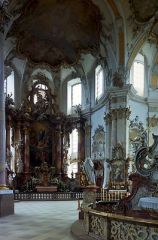
?
|
|
|
Balthasar Neumann
Residenz, Wurzburg Germany 1743-72 |

?
|
|
|
Balthasar Neumann
pilgrimage chapel of Vierzehnheiligen, Germany 1743-72 |

?
|
|
|
Germain Boffrand, Salon de la Princesse, Hôtel de Soubise, Paris, 1737-40
Typical french Rococo, Curvy lines. Ornate and luxurious. |

?
|
|
|
Antoine Watteau, Return from Cythera, 1717-19
Depicted outdoor entertainment or amusements of upper-class society. Rococo. Love and happiness. |

?
|
|
|
François Boucher, Cupid a Captive, 1754.
Rococo. Arcadian shepherds, nymphs, and goddesses. Painter for Madamae de Pompadour (Louis the XV mistress) |
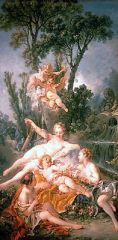
?
|
|
|
François Boucher, Madame du Pompadour, 1756, French.
Rococo. Was a common patron of Boucer, Louis the XV's mistress. |
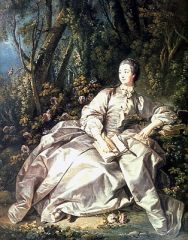
?
|
|
|
Jean Honoré Fragonard, The Swing, 1767, French
Rococo. Was Boucher's student, master of detail. Shows flirtation. |
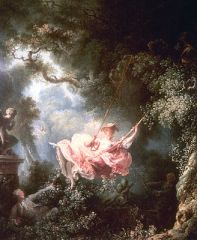
?
|
|
|
Clodion, Satyr and Bacchante (Intoxication of Wine), 1775, Terracota, French.
Combines Rococo fantasies with echoes of Bernini's figures. Open and active, but more playful. |

?
|
|
|
William Hunter, Child in Womb, 1774.
From the dissection of a woman who died in the ninth month of pregnancy. Shows interest in study of human body. Used for the education of surgeons and physicians. |
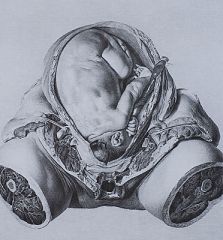
?
|
|
|
Abraham Darby III and Thomas F. Pritchard, Iron Bridge at Coalbrookdale, England, 1776-79
First cast iron bridge over Severn River. Exposed structure was influential on later works, such as Eiffel Towe. |

?
|
|
|
Joseph Wright of Derby, A Philosopher Giving a Lecture at the Orrery, ca. 1763-65. Neoclassism. Shows enthusiasm for technological advances and mechanical explanations for wonders of universe. Caravaggio like dramatic lighting. Everyone in painting is caught up in wonders.
|
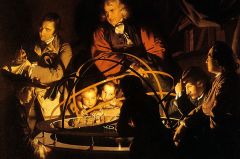
?
|
|
|
Jean Baptiste Greuze, The Village Bride, 1761.
Happy climax to a rural romance. |
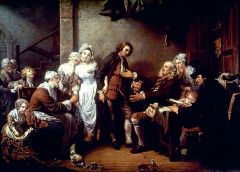
?
|
|
|
Élisabeth Vigée-Lebrun, Marie Antoinette and Children, 1787, French
|
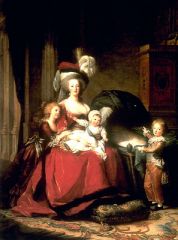
?
|
|
|
Jean Baptiste Chardin, Grace at Table, 1740, French.
Early neoclassicism, naturalistic. Quiet scenes of domestic life. Praises simple goodness of ordinary people. |

?
|
|
|
Élisabeth Vigée-Lebrun, Self-Portrait, 1790
Naturalism in french portraiture. Self confidence in pose shows her independent role in society. Looks directly at viewers. |
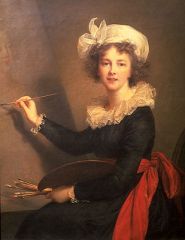
?
|
|
|
Thomas Gainsborough, Mrs. Richard Brinsley Sheridan, 1785-87.
Lovely woman in matches unspoiled beauty. Artists interest in landscape is evident. |

?
|
|
|
William Hogarth, The Tête à Tête, from the series Marriage a la Mode, 1745.
Made narrative prints that read like chapters in a book. Satire on marraige. |
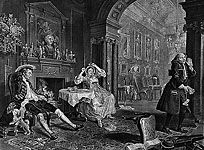
?
|
|
|
Benjamin West, The Death of General Wolfe, 1771.
Neoclassicism, shows hero. Shows wounded English commander just after defeats of French in battle Quebec, gave canada to great Britain. |
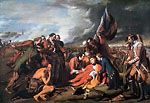
?
|
|
|
John Singleton Copley, Portrait of Paul Revere, ca. 1768-70.
Shows directfulness and faithfulness, appealed to Americans. Showed revere before he was a hero, just a silversmith. |
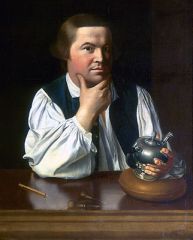
?
|
|
|
William Hogarth, Breakfast Scene, from the series Marriage a la Mode, 1743. Made narrative prints that read like chapters in a book. Satire on marraige.
|
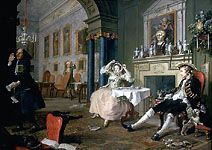
?
|
|
|
Antonio Canaletto, Basin of San Marco from San Giorgio Maggiore, ca. 1740, Italian.
Characteristic scene of Venice to sell to British as a souvenir. Very picturesque, shows venetian landscapes. Worked on location. |

?
|
|
|
Angelica Kauffman, Cornelia Presenting Her Children as Her Treasures, ca. 1785, Swiss, Neoclassicism. Model of virtue from Greek and Roman history and literature. Clothed in ancient roman garb, roman interiors. Rococo elements of charm and grace still linger.
|
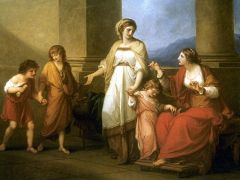
?
|
|
|
Jacques-Louis David, Oath of Horatii, 1785, French, Neoclassicism. Matter should have moral. Marks heroism and civic virture. Story from pre-historic rome that echoed idea of the french revolution at the time.
|
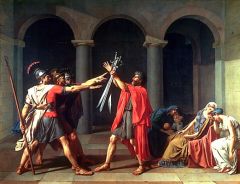
?
|
|
|
Jacques-Louis David, Death of Marat, 1793, French, Neoclassicism.
Was to provide inspiration and encouragement to revolutionary forces. Was a revolutionary radical and writer who was assassinated. |

?
|
|
|
Jacques-Germain Soufflot, tha Panthéon (Sainte Geneviève), Paris, France, 1755-92.
Turned away from theatricality and ostentation of Baroque and Rococo, more classical look. Revived interest in greek and roman cultures. |
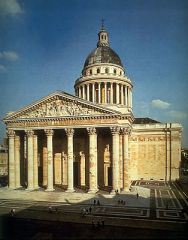
?
|
|
|
Jacques-Louis David, The Coronation of Napoleon, 1805-1808, French, Neoclassicism.
One of major paintings he produced as first painter for the empire for Napoleon Bonaparte. Large scale, shows pomp and pageantry. |

?
|
|
|
Pierre Vignon, La Madeleine, Paris, France, 1807-1842, Neoclassicism.
Built as temple of glory for Napoleon's armies as a monument for their victories for france. Corinthian columns recall roman imperial temples. |

?
|
|
|
Antonio Canova, Pauline Borghese as Venus, 1808, Italian, Neoclassicism.
Napolean's sister wanted to be shown as Venus, goddess of love. Sharply detailed, shows commitment to naturalism. |
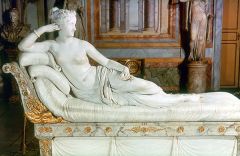
?
|
|
|
Antonio Canova, Cupid and Psyche, 1787-93, Marble, Italian, Neoclassicism
|
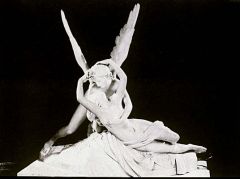
?
|
|
|
Richard Boyle (Earl of Burlington) and William Kent, Chiswick House, near London, England, begun 1725, Neoclassicism.
Variation on theme of Palladio Villa Rotonda. Very simple, clear, unadorned planes and right angles. Classical and rational. |
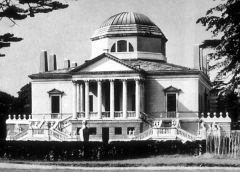
?
|
|
|
Robert Adam, Design for Etruscan Room, Osterley Park, Middlesex, England, begun 1761
Shows return of complete symmetry and rectilinearly shape. Louis XIV's splendor and decorative style. |
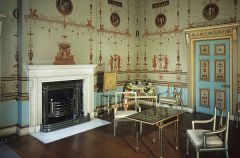
?
|
|
|
Josiah Wedgwood, Apotheosis of Homer (vase), Jasparware, 1786, British
|

?
|
|
|
Thomas Jefferson, Monticello, near Charlottesville, Virginia, 1770-1806, American.
Jefferson was interested by classical architecture, showed in his design for his own home. Reminiscent of Villa Rotunda and Chiswick House, but used local wood and brick. |
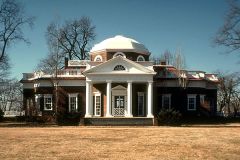
?
|
|
|
Gilbert Stuart, George Washington (Lansdowne Portrait), 1796.
|
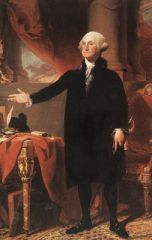
?
|
|
|
Edmonia Lewis, Forever Free, 1867, Marble, American.
Neoclassicism. Displayed freed African American slaves. Stands in contrapposto. Woman kneeling acknowledges woman's subordination. |
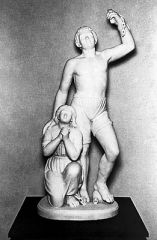
?
|
|
|
Antoine-Jean Gros, Napoleon at the Pesthouse at Jaffa, 1804, French.
Shows Napoleon, fearless and in control among those dying of the bubonic plague. Comforts still alive, painting was supposed to help his image. |
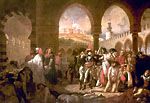
?
|
|
|
Jean-August-Dominique Ingres, Napoleon I on his Imperial Throne, 1806.
Now more emphasis on line and composition than emotion. Curving lines of robe and throne, coronation. |
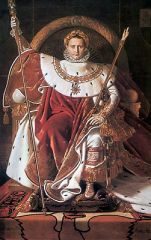
?
|
|
|
Jean-August-Dominique Ingres, Grande Odalisque, 1814.
Reveals his knowledge of Mannerism. Shows precision of observation, but peculiar abstraction. almost modest in face, elongated in arms , tiny waist, detailing in broach and head drapery makes her believable. |
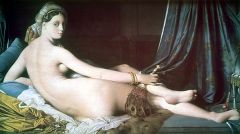
?
|
|
|
Jean-August-Dominique Ingres, Apotheosis of Homer, 1827, French
Neoclassicism, not best to show Ingres, but shows neoclassicism and academy tradition. Homer is being crowned, seated in front of classic temple of Ionic order. can be compared to school of athens, but certain objectives in both of them. |
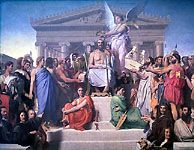
?
|
|
|
Giovanni Battista Piranesi, Carceri d'Invenzione, pl. 14, ca. 1750, Italian.
Romanticism. He was an architect, known for etchings.Invensions of prisms, 1750. looks like theatrical set. Its oppressive, towers over you, you wouldn't want to get locked in, haunting. |

?
|
|
|
Horace Walpole, Strawberry Hill, England, 1749-77
View from south. Now many patrons have many shifts in styles, such as neogothic. Strawberry Hill. Very peculiar building with certain medieval features. No rational, no balance, Inside, english medival gothic architecture, recreate worlds for themselve, can be almost anything. |
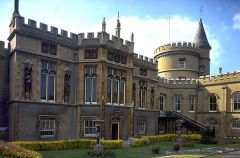
?
|
|
|
Henry Flitcroft and Henry Hoare, Park at Stourhead, 1743, English
|
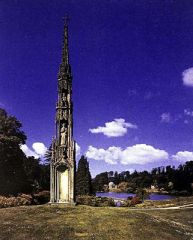
?
|
|
|
Henry Flitcroft and Henry Hoare, Park at Stourhead, 1743, English
|
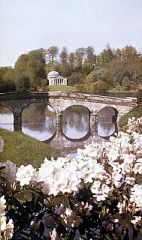
?
|
|
|
John Henry Fuseli, The Nightmare, 1781, British.
Romanticism. Swiss, emigrated to london. Drew upon literary traditions and fantasies, especially nightmares. First to try to depict the human subconscious. |
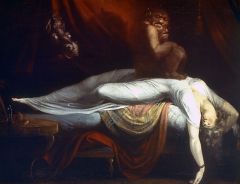
?
|
|
|
John Henry Fuseli, Milton Dictating to His Daughter, 1799, British. Romanticism.
|
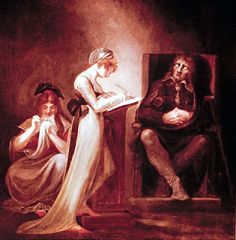
?
|
|
|
William Blake, Ancient of Days, frontispiece of Europe: A Prophesy, 1794, British.
Romanticism. Was poet as well, got inspiration from his dreams. Combined idea of God as wisdom and as creator. Full of energy, classic anatomy. |
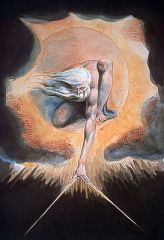
?
|
|
|
Francisco de Goya, Third of May, 1808, 1814, Spanish.
Romanticism. Shows Napoleon soldiers executing unarmed spanish peasants. Makes you feel sympathy for peasants. Man in middle stands in crucifix gesture. |
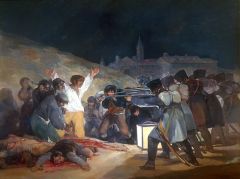
?
|
|
|
Francisco de Goya, Sleep of Reason Produces Monsters, from Los Caprichos, ca. 1798, Spanish.
Romanticism. Shows himself sleeping on a table as he is threatened by monsters. Commitment to Romanic spirit and unleashing of imagination, emotions, and nightmares. |
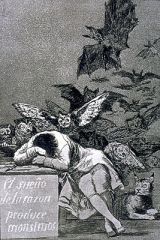
?
|
|
|
Francisco de Goya, Saturn Devouring His Children, 1823.
Was painted on walls of his farmhouse, only for his viewing. Showed the extreme pessimism and depression he went through later in life. Expresses artists despair. |

?
|
|
|
Théodore Géricault, The Raft of the Medusa, 1819.
Romanticism. Introduced theatricality into a historic scene. A French ship hit a reef, and the survivors made a raft. X shaped composition. |
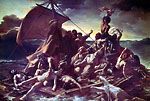
?
|
|
|
Théodore Géricault, Insane Woman (Envy), 1822-1823.
Scientific interest in mental disorders as well as morbid romantic interest in death. Face is tense, eyes red, her suffering is visible. |
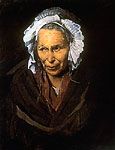
?
|
|
|
Eugène Delacroix, Death of Sardanapalus, 1828.
Romanticism. Last hour of Assyrian king, watches his most prized possessions be destroyed. Crowded and tempestuous composition, rich and intense hues. |
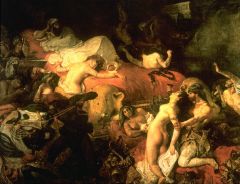
?
|
|
|
Eugène Delacroix, Liberty Leading the People, 1830 (G 20-48).
Romanticism. Inspired by Greeks struggle for freedom against the Turks at the time. Allegorical personification of liberty, You cam sense the urgency. |
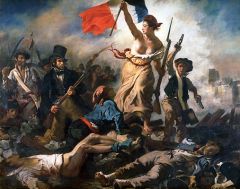
?
|
|
|
Eugène Delacroix, Women of Algiers, 1834, French
|
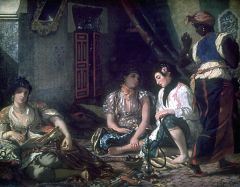
?
|
|
|
Eugène Delacroix, Wild Horse Felled by a Tiger, 1828, French
|
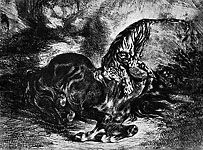
?
|
|
|
Eugène Delacroix, Royal Tiger, 1829, French
|

?
|
|
|
Jean Leon Gérôme, Slave Market, 1866, French
|
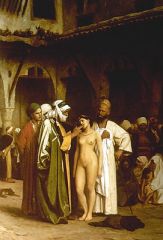
?
|
|
|
Antoine-Louis Barye, Jaguar Devouring a Hare, 1850-1851, French sculpture.
Romanticism. Delacroix interest with raw beauty and bestial violence. You can tell he observed animals for a while. Intense muscle of jaguar contrasted by limp body of hare. |

?
|
|
|
Caspar David Friedrich, Abbey in the Oak Forest, 1810, German.
First to bring ideas of Romanticism to landscape. Leafless oaks in a snow covered cemetery. Balances inner and outer experiences. |
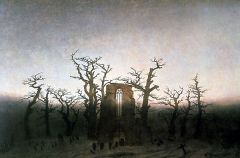
?
|
|
|
Caspar David Friedrich, Monk by the Sea, 1809, German.
Romanticism. Solitude. |

?
|
|
|
John Constable, The Hay Wain, 1819-21, English.
Depicted tranquil English countryside. Studied meteorology to capture texture of the atmosphere. Significant because it doesnt show the civic unrest of the working class in that region at the time. |
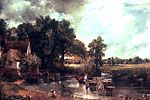
?
|
|
|
Joseph Mallord William Turner, The Slave Ship, 1840, English.
Romanticism scene in turbulent swirls of waves. Shows incident where captain of slave ship threw sick passengers overboard, because his insurance would reimburse him. |
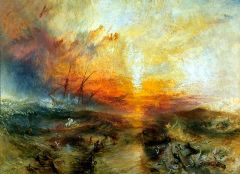
?
|
|
|
Joseph Mallord William Turner, Rain, Steam and Speed--The Great Western Railway, 1844, English
|

?
|
|
|
Thomas Cole, The Oxbow, 1836, United States.
Romantic landscape as well as exploration of america. Focused on geographic qualities that made America unique. Shows lazy scene of Connecticut River. |
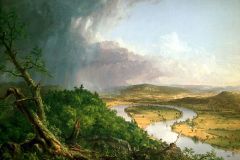
?
|
|
|
Thomas Cole, The Architect's Dream, 1840, American
Detail of architect in lower right corner |
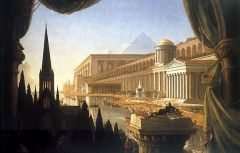
?
|
|
|
Albert Bierstadt, Among the Sierra Nevada Mountains, California, 1868, American.
Traveled west, depicted awe inspiring scenes of the Rocky mountains. Enforced the idea of the Manifest Destiny. (doctrines that said westward expansion of US was logical destiny) |
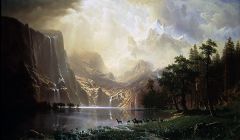
?
|
|
|
Frederic Edwin Church, Twilight in the Wilderness, 1860.
Hudson River School. Very well traveled. Paintings still had feeling of the Romantic sublime.Does not show civil war that was occuring at the time, in fact humanity at all is seen, completely tranquil. |
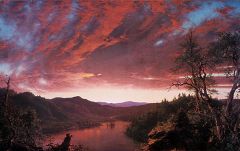
?
|
|
|
John Nash, Royal Pavilion at Brighton, England, 1815-18 - East façade.
Conglomerate of Islamic architectural facets, known to be called "Indian Gothic". Nash was an established Neoclassical architect when he created this. |
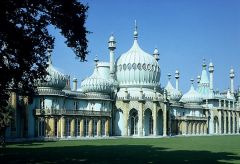
?
|
|
|
J.L. Charles Garnier, the Opera, Paris, 1861-1874.
Shows grandeur and opulence of the few rich French at the time. Mimics the Louvre's facade.- charles garnier, criticized eiffel tower, build paris opera. steel frame. still relied on classical orders. very ornate but also functional.place to see and be seen, balconies are as visible as stage. was part of a bigger plan for the city. |

?
|
|
|
John Paxton, Crystal Palace, London, 1850-1851
- john paxton, crystal palace: won a contest to build structure, wanted it to be very iron, all glass with iron from. hugeeeee. topped by semicircular vault, because they couldnt remove or clip trees, so had to build around them. mass production allowed it to be completed in a very short time. innovated structure and production. |

?
|
|
|
John Paxton, Crystal Palace, London, 1850
|

?
|
|
|
Gustave Eiffel, Eiffel Tower, 1889.
build for 1889 paris world's fair. gustave eiffels firm also built framework for statue of liberty. supposed to be site for experiments, showed progess.criticized for being useless and monstrous. |

?
|
|
|
Eugène Durieu and Eugène Delacroix, Draped Model (back view), ca. 1854.
Collaborative efforts of painter and photographer. Effort to make photography more than just reproduction of an image my using careful lighting and draping of cloth. |
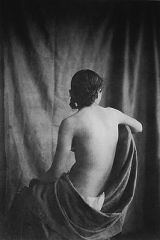
?
|
|
|
Louis Jacques Daguerre, The Artist's Studio, 1837.
Each daguerrotype is unique, has amazing detail and fine graduating from black to white. One of the first successful plates. Light and shadow show 3 dimensionality of forms. |

?
|
|
|
William Henry Fox Talbot, The Open Door, plate VI from The Pencil of Nature, 1843
|
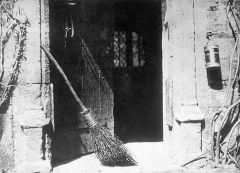
?
|
|
|
Josaih Johnson Hawes and Albert Sands Southworth, Early Operation under Ether, Massachusetts Genral Hospital, ca. 1847, Daguerrotype.
Puts viewer in feet of medical students in the gallery watching the procedure. Gives viewer a glimpse of the western medical practice. Blurring is due to slight movement during the exposure. |
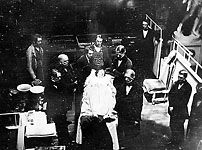
?
|
|
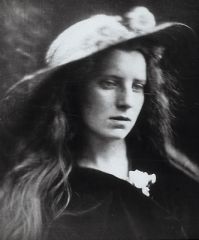
?
|

Julia Margaret Cameron, Ophelia, 1867, British, Albumen print.
- julia margaret cameron, showed more artistic photographs, came from money so she could experiment. ophelia, was her maid, depicted her as the character from hamlet. directional lighting, focused on sitters faces. wanted her paintings to be considered high art. deliberately out of focus to separate from comtemporary photographs. |
|
|
Lewis Carroll, Alice Liddell as a Beggar Child, 1859, British.
photographed subjects through the eyes of others. alice liddel as a begger child, exaggerated supposed role. inspired alice in wonderland, books are mirrored in photographs. also have victorian conception of innocence of childhood. |
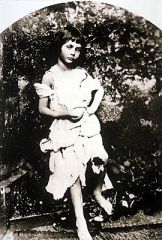
?
|
|
|
Nadar, Eugène Delacroix, ca. 1855, Modern print from an original negative.
|
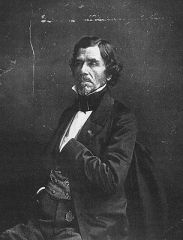
?
|
|
|
Timothy O'Sullivan and Alexander Gardner, A Harvest of Death, Gettysburg, Pennsylvannia, July 1863, Albumen print.
documented civil war, sought out to show valliant soldiers, but instead found corpses, showed that war was not glorious. sometimes moves bodies for artistic affect, changes view as phtograph as piece of art of document. |
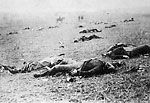
?
|
|
|
Gustave Courbet, The Stonebreakers, 1849, French.
Realism. most menial of all possible labor, young man and old man. uses dirty browns and greys to convey the dreary and dismal nature of the task. |
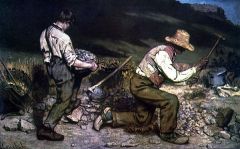
?
|
|
|
Gustave Courbet, A Burial at Ornans, 1849-50, French,
Realism. llled composition with figuers. cuts off compotision with platuea, hard surface life. shows his view of burial, lame hole in foreground of painting. a very minimal celebration, shocking by comparison of burial of count ornaz, Very ordinary. |

?
|
|
|
Jean François Millet, The Gleaners, 1857, French
Realism. Millet, rural and rural poor. "the gleaners", dont show faces so its the act of labor. do most menial labor of gleaning the last wheat scraps. Shows growing movement of socialism. |
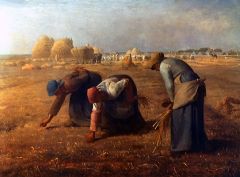
?
|
|
|
Honoré Daumier, Rue Transnonain, 1834, French.
Realism. Comedic comics give illierate ability to make own opinions on issues. rue transnonian, shows massacre in urban ghettos of paris. Compare to Goya's The Third of May |
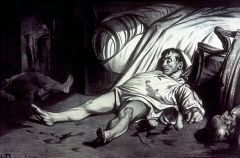
?
|
|
|
Honoré Daumier, Nadar Raising Photography to the Height of Art, 1862, French lithograph.
Commentary after photography was already legally verified as art. Nadar was very passionate of the possibilities of photography. |
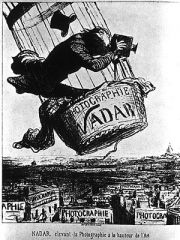
?
|
|
|
Honoré Daumier, Third Class Carriage, ca. 1862,
Realism, very loose brush strokes. Third class carriage", shows plight of urban poor. Unposed, anonymous and insignificant. Showed people as you generally see them, vague, impersonal, and blank. Unfinished. |
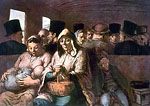
?
|
|
|
Édouard Manet, Olympia, 1863, French.
Realism, very young white prostitute on very white sheet, next to very black cat and very black maid, shows racial divide. she looks ar viewer again, equal amounts of attention. COMPARE TO TITIANS VENUS OF URBINO and ANGRAS images too." Strokes are rougher and shifts in tonality are more abrupt. |
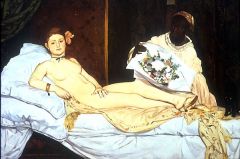
?
|
|
|
Édouard Manet, Le Dejeuner sur L'Herbe (Luncheon on the Grass), 1863, French
Realism. Manet was less driven to shock poeple, but more radical in his techniques, so people would be shocked but not his intention. flattens his subjects. "lucheon on the grass", women are nude and men are not. everything is flattened out. comepare giogone/titian, diference is that nudes are muses, dont look at viewer, manet's do, challanges and questions tradtions, try to use in differnt names. |
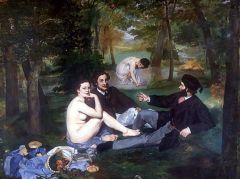
?
|
|
|
Édouard Manet, Portrait of Emile Zola, 1868.
Realism. wrote about cortizens, paintings in background show study of velazquez and japanese prints, and olympia. challegene establishments. |
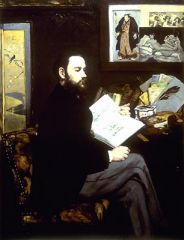
?
|
|
|
Johann Zoffany, Academicians of the Royal Academy, 1771-72
|

?
|
|
|
William Adolphe Bouguereau, Nymphs and Satyr, 1873.
Classical mythological subjects, flirtatious and ideally beautiful nymphs. Very naturalistic, not realist. |

?
|
|
|
Jean Leon Gérôme, Death of Caesar, 1859
|
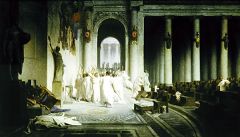
?
|
|
|
Marie-Rosalie (Rosa) Bonheur, The Hourse Fair, 1853-1855.
If it wasnt designates at a woman artist wouldnt be able to tell. shows country life with horses, not exactly genre but full of action and strength of horses |
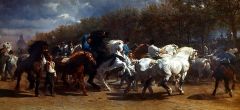
?
|
|
|
Thomas Eakins, The Gross Clinic, 1875
. Realism. Very bloody scalpal and hand. anesthesiologist with cloth over patients face, patients wife is watching over in pain. uses chiaroscuro to highlight bloody hand. Realist because of these details, but academic tradition in lighting in compostition. much like rembrants dr tulp. long tradition of representing operations or cadavers being observed. |
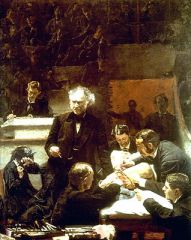
?
|
|
|
Eadweard Muybridge, Galloping Horse, 1878, Photogravure.
Showed illusion of motion. Was beginning of his studies in the successive stages in human and animal motion that was too quick for the human eye to capture. |

?
|
|
|
John Singer Sargent, The Daughters of Edward Darley Boit, 1882
Realism. Rich girls with maids, maids are dwarfed by large porcelaine. Rug and vase show he had looked at asian prints. he did many portraits of well off families. compare to velazquezes las meninas. you can see the change in fashion, change in group portraits. |
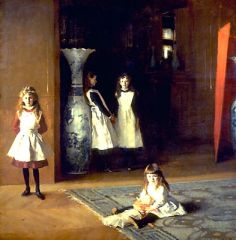
?
|
|
|
Dante Gabriel Rossetti, Annunciation, 1849
|

?
|
|
|
Dante Gabriel Rossetti, Beata Beatrix, ca. 1863
Pre-Raphaelite Brotherhood. Literary subject of Beata from Dante's Vita Nuova. Has a victorian prettiness and sensual allure. |

?
|
|
|
John Everett Millais, Ophelia, 1852.
Pre-Raphaelite Brotherhood. Disregarded realism, chose to represent fictional and historical subjects with degree of convincing illusion. Subject is drowning of Ophelia from Hamlet. |
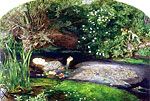
?
|
|
|
William Holman Hunt, Awakening Conscience, 1852
|
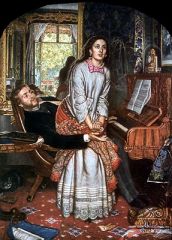
?
|
|
|
John Everett Millais, Christ in the House of His Parents, 1850.
Pre Raphaeilite Brotherhood. Literary and biblical subjects. |

?
|
|
|
James McNeill Whistler, Nocturne in Black and Gold (The Falling Rocket), ca. 1874.
Impressionism. Interest in sensations color produces on the eye. Fireworks, light disrupts dark sky. |

?
|
|
|
Claude Monet, Impression: Sunrise, 1872.
Sunrise, coined impressionism. Captures transitory, subject matter is emphasized on what is going on now in the everyday. The moment. The quick glance and the impression you take away. fascinated with the oranges and blues, mixes and organizes colors. greater range of color before. emphasis of flattening surface. |
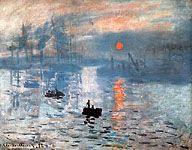
?
|
|
|
Pierre Auguste Renoir, Moulin de la Galette, 1876.
Impressionism. Showed leisure time that industry made possibly by work hours. applying loosened brushwork and scattered light coming in through trees. contemporary dress. middle to lower class, still dressed up and dancing. known for his depiction of women. |
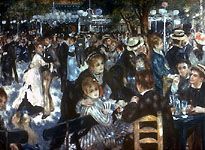
?
|
|
|
Claude Monet, Saint-Lazare Train Station, 1877.
Impressionism. Structures more transparent, like the other glass building in london. smoke obscures it, but shows industrial development and expansion of railway network. |
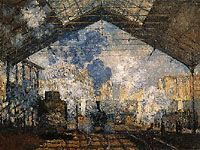
?
|
|
|
Gustave Caillebotte, Paris: A Rainy Day, 1877.
Impressionism. Was interested in modernity and asian prints. very grey (enhances color) umbrellas all the way across gives movement. Is couple isolated or part of? where is middle (focal point) of the painting? very involved in the surface, wet ground is very detailed. Shows redesigning of Paris that was going on. |
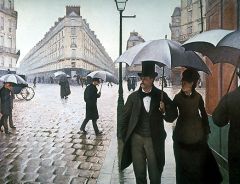
?
|
|
|
Camille Pissarro, La Place du Théâtre Français, 1898.
Impressionism. joins the group kind of, less interested in loose brushwork, more interested in street life. view from very high above. urban landscape. |
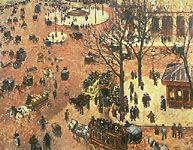
?
|
|
|
Édouard Manet, A Bar at the Folies Bergère, 1881-82.
Impressionism. Barmaid all dressed up to serve guests, looks disinterested of lost in thought. is she looking at us or do we see her back? chandeliers and figures in back are confusing, faces go into obscurity. Works as reflection in glass, but then that creates other problems. |

?
|
|
|
Edgar Degas, Vicomte Lepic and Daughters, 1873
Impressionism. capturered wealthy man and daughters going for a walk in an urban environment, very odd composition, cuts them off at waist, experiments with handling of space and momentarity of life in the city. |

?
|
|
|
Edgar Degas, Glass of Absinthe, 1876
Impressionism. amous glass of absinth, cut off and handling of view is equally different. two individuals are sitting next to each other, but are not together, both have been drinking some of the absinthe. pretty devastating effect. she has very spacey look on her face. flattens out surface, shadows play with figures, lightened up brushwork. slouch in shoulders. |

?
|
|
|
Edgar Degas, Ballet Rehearsal, 1874.
Impressionism. degas is fascinated with ballet. ballet rehearsal, directional lines leading you one way and then cutting you off, brings you into pictoral space. emphasized surface and also light off tutus. |

?
|
|
|
Edgar Degas, The Tub, 1886.
Impressionism. did in pastel. you can tell by surface. looking down on woman bathing (nude study?) play of curve of her back against curve of big tub, shelf cuts across, plays against the curves. |
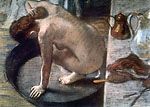
?
|
|
|
Pierre Auguste Renoir, La Loge, 1874.
Impressionism. Known for his portraits of women. At the opera again. man in background obviously looking at somewhere else, social scene of paris. |
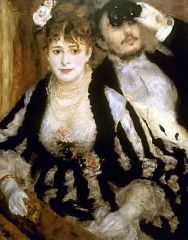
?
|
|
|
Claude Monet, Rouen Cathedral, 1894.
Impressionism. monet does meticulous studies of many things and light, color, and facades of buildings. interested in how color reacts to light. |
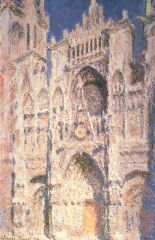
?
|
|
|
Berthe Morisot, Villa at the Seaside, 1874.
Impressionism, in thick brushstrokes and enjoyment of the moment. Plein air lighting. Train made it possible for parisians leisure at the seaside. |
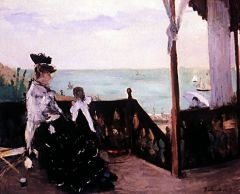
?
|
|
|
Mary Cassatt, The Bath, ca. 1892.
Impressionism. view from above (japanese prints) flattening out in background (degas). Did many portraits of mother and daughters, often her friends children. |
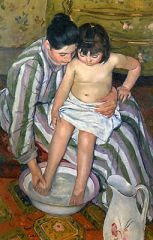
?
|
|
|
Mary Cassatt, Woman at the Opera, 1879.
Impressionism. also interested in the theatre curious boxes of opera (cant see stage but you can people watch) |
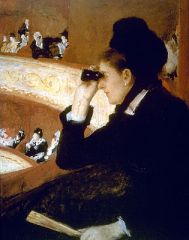
?
|
|
|
Henri de Toulouse Lautrec, At the Moulin-Rouge, 1892-95.
Had satirical edge that bordered on caricature. aristocrat. very small person. setting in painting kind of like absinth party. women in forground same green. silouttes of people, high fashions. |
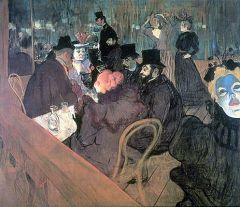
?
|
|
|
Georges Seurat, Sunday Afternoon on the Island of the Grande Jatte, 1884-86.
Post Impressionism. juxtapose reds and greens, but reduced to tiny dots, you eye mixes on your own. shows what working people do on weekend, as opposed to aristocratic people who played all week. everything comes to life with tiny little dots. |

?
|
|
|
Georges Seurat, The Eiffel Tower, 1889.
Post impressionism, tiny dots. |

?
|
|
|
Vincent Van Gogh, Self-Portrait with Bandaged Ear, 1889.
Post impressionism. |

?
|
|
|
Vincent Van Gogh, The Night Café, 1888.
Post-Impressionism. Benign scene that he charges with energy with juxtaposition of red and green. Was supposed to convey a place where one could go mad. |
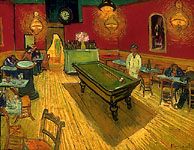
?
|
|
|
Vincent Van Gogh, Starry Night, 1889.
Post-Impressionism. Showed vastness of universe with exploding stars and galaxies. Church nestled in middle may represent his mixed feelings about religion. |
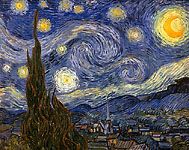
?
|
|
|
Paul Gauguin, Self-Portrait, 1889.
Post impressionism. Expressive line, color, and composition. |
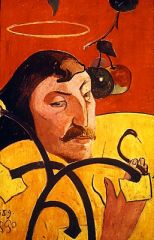
?
|
|
|
Paul Gauguin, Vision After the Sermon, 1888.
Shows women in church visualizing sermon. Wanted viewer to focus on the idea instead of image. Expressive color and interesting perspective. |
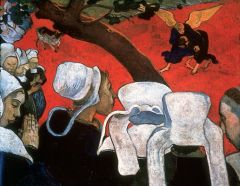
?
|
|
|
Paul Gauguin, Where Do We Come From? Who Are We? Where are We Going?, 1897.
Post Impressionism. Painted just before he committed suicide. Summarizes his artistic methods, flat shapes of pure color. |

?
|
|
|
Paul Cézanne, Mont Sainte-Victoire, 1904-06.
Post impressionism. Explored properties of line, plane, color and thier interrelationships. Cool colors recede, warm ones advance. |

?
|
|
|
Paul Cézanne, Still Life with Basket of Apples, 1890-94.
Post-Impressionism. juxtaposing form and color. why is the vertical plaed where it is, why is it next to tilted basket. doesnt pay attention how table supports it. - monte sainte-victoire, did this painting over and over again, each time playing with detail and color and placement. fascinated with architectural form of house. |
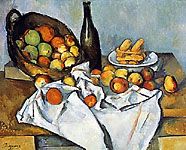
?
|
|
|
Paul Cézanne, Large Bathers, 1898-1906.
Post Impressionism. He is a real sensualist. very fleshy bodies, lots of blue and oranges. questions why he is choosing to do what hes doing. |
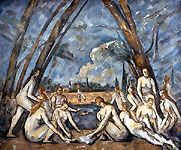
?
|
|
|
Pierre Puvis de Chavannes, The Sacred Grove, 1884.
Like the bathers, not a realist, he doesnt really fit into a category. all figures are a bit isolated. almost fantasy like. |
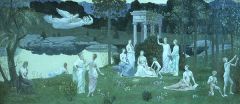
?
|
|
|
Gustave Moreau, Jupiter and Semele, ca. 1875.
Juniper appears to Semele, sigh is so powerful she dies from it. Everything is encrested, almost fear of empty space. loved the opera, and decorative arts, Rich and exotic looking. |
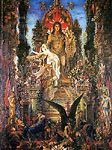
?
|
|
|
Odilon Redon, The Cyclops, 1898.
Symbolism and fantasy come together, drawn on mythological traditions. cyclops looks very innocent. galatea lays in mass of colors. |
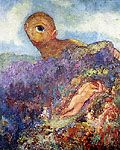
?
|
|
|
Henri Rousseau, The Sleeping Gypsy, 1897.
Weekend painter, not trained. hair and face begins to merge with desert background. tiger, instead of eating him sniffs him. completely naive approach, but so different. innocent, but probing and examinatin of color and form. |
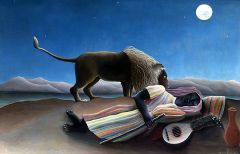
?
|
|
|
Edvard Munch, Scream, 1893.
expressive use of color, very angled and cut off, like absinth or moulin rouge. whole atmosphere is responding to scream. very haunting figure, captures anguishes of modernity. |
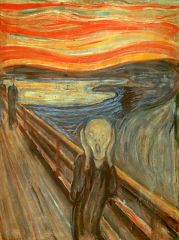
?
|
|
|
Jean-Baptiste Carpeaux, Ugolino and His Children, 1865-1867.
Based on Dante's Inferno, Count Ugolino and sons shut up in a tower to starve to death. Twisted, intertwined, tormented. |
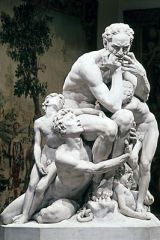
?
|
|
|
Auguste Rodin, Walking Man, 1905.
Captures sense of body in motion. Caught in mid-stride when weight is transferred. |

?
|
|
|
Auguste Rodin, Burghers of Calais, 1884-1889.
Life sized group commissioned to commemorate a heroic episode from Hundred Years War. All look very ragged and in despair. |

?
|
|
|
William Morris, Green Dining Room, London, England, 1867
|
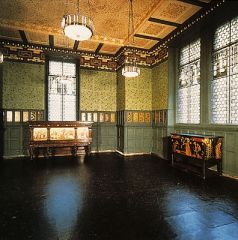
?
|
|
|
Charles Rennie Mackintosh, Ladies' Luncheon Room (reconstruction) from the Ingram Street Tea Room, Glasgow, Scotland
|
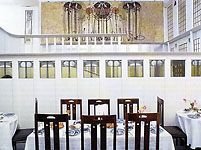
?
|
|
|
Victor Horta, staircase in the Van Eetvelde House, Brussels, Belgium, 1895
|
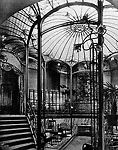
?
|
|
|
Aubrey Beardsley, The Peacock Skirt, 1894, pen & ink illustration for Oscar Wilde's Salomé
|

?
|
|
|
Anonio Gaudi, Casa Mila, Barcelona, Spain, 1907
|
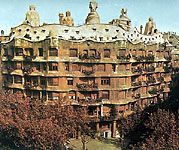
?
|
|
|
Gustave Klimt, The Kiss, 1907-08
|

?
|
|
|
Henri Matisse, Woman with the Hat, 1905
Expressionism: Fauvism. took the color and ran. swirl of colors through hat, circulation of colors through dress as well, looks unfinished, but matisse liked to give breath of sponieity, order and control contrasted with sponineity, very loose brushwork. inconsistency give wild look. |

?
|
|
|
Henri Matisse, Blue Nude, Souvenir of Biskra, 1907.
Expressionism: Fauvism. reminisce of cezannes nude bathers. as much energy as in dance in one figure. much like michelangelos nude, very full and emotional. echos form of her body with architecural background. loose and free form, breaks lines and contours. all these artists start to look at african art. |

?
|
|
|
Henri Matisse, Harmony in Red, 1908.
Expressionism: Fauvism. Mural size. arranging things on a flat surface, parallels to making art. flattened all by using all one color. loves building a discipline, can be seen in chair, but takes that away by removing edge of table. began to study islamic art. likes to let colors breath by leaving a little white between the colors. flattens forms like cezanne. |
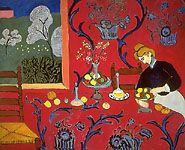
?
|
|
|
Henri Matisse, The Dance, 1910.
Expressionism: Fauvism. looks back to antiquity. showed figures moving and winding through space. very flat but curves gives idea of 3dimensiionality and dynamic, vigorous and expressive. tried very hard to be simple. |

?
|
|
|
Andre Derain, The Dance, 1906
Expressionism: Fauvism. abstraction of classical poses, making wild the romanesque figures. |
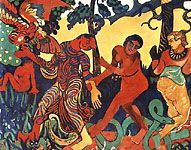
?
|
|
|
Ernst Ludwig Kirchner, Street Scene, Dresden, 1908
Expressionism: The Bridge. Compare with monet's street scene, very different, uses very uncharacteristic colors. figure meets us head on, contour brings her out of painting. colors, shows a very riskay street peope (including street walkers) modern and liberating. influences by munch. |
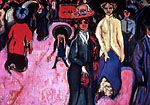
?
|
|
|
Emile Nolde, The Last Supper, 1909.
Expressionism: The Bridge. Northern prodestant, didnt belong to an individual church, more popular to just read bible at that time. shows christ surrounded by disciples, physical proximity and spiritual scene of last supper. |
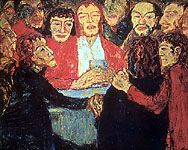
?
|
|
|
Emile Nolde, Saint Mary of Egypt among Sinners, 1912.
Expressionism: The Bridge. Part of tryptich. shows mary as a prostitute, to make money for pilgramage. then shows her conversion, shows her sensuality in vulumptous figure, passion for religion, usually shown as so skinny from faith. |

?
|
|
|
Vassily Kandinsky, Improvisation No. 28, 1912.
Expressionism: The Bridge |

?
|
|
|
Franz Marc, The Large Blue Horses, 1911
Expressionism: The Bridge |

?
|
|
|
Franz Marc, Fate of the Animals, 1913
Expressionism: The Bridge |
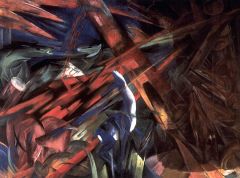
?
|
|
|
Paula Modersohn-Becker, Self-Portrait with Amber Necklace, 1906
|
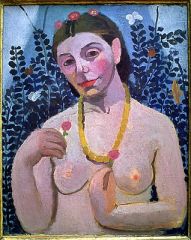
?
|
|
|
Pablo Picasso, Gertrude Stein, 1906-07
Cubism |
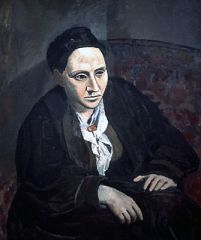
?
|
|
|
Pablo Picasso, Les Demoiselles d'Avignon, 1907
Cubism "I paint forms as I think them." |
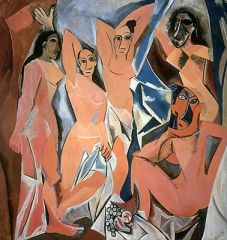
?
|
|
|
Georges Braque, The Portugese, 1911
Analytic Cubism |
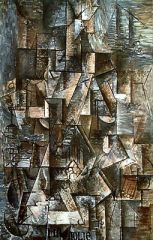
?
|
|
|
Pablo Picasso, Still Life with Chair Caning, 1911-12.
Synthetic Cubism |
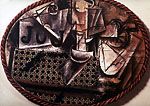
?
|
|
|
Georges Braque, Bottle, Newspaper, Pipe and Glass, 1919
Synthetic Cubism |
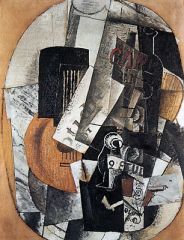
?
|
|
|
Robert Delaunay, Champs de Mars (or The Red Tower), 1911
Analytic Cubism |

?
|
|
|
Sonia Delaunay-Terk, Coat, 1924
Cubist Sculpture |
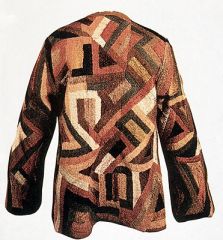
?
|
|
|
Pablo Picasso, cardboard, string and wire maquette for Guitar, 1912.
Cubist Sculpture |
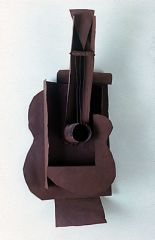
?
|
|
|
Jacques Lipchitz, Bather, 1917
Cubist Sculpture. Continuous mass, intersecting planes. |

?
|
|
|
Julio Gonzáles, Woman Combing Her Hair, ca. 1930-1933.
Cubist sculpture, interplay or curves, lines, and planes, almost a complete abstraction. |

?
|
|
|
Fernand Léger, The City, 1919
Purist, affected by synthetic cubism. monumental scale. |
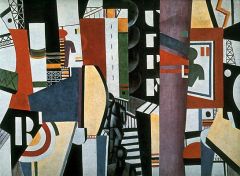
?
|
|
|
Giocomo Balla, Dynamism of Dog on Leash, 1912, Futurism
|
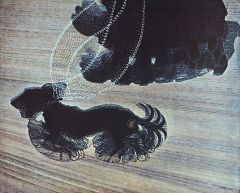
?
|
|
|
Giocomo Balla, Mercury Passing in Front of the Sun, 1914.
Futurism, speed. |
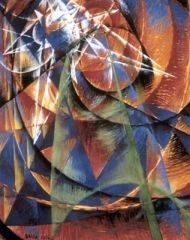
?
|
|
|
Umberto Boccioni, Unique Forms of Continuity in Space, 1913, Futurism
|
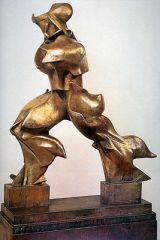
?
|
|
|
Gino Severini, Armored Train, 1915.
Futurism. |
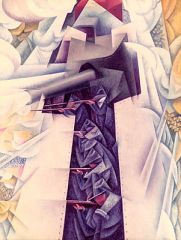
?
|
|
|
Hans (Jean) Arp, Squares Arranged According to the Laws of Chance, 1917.
Dada. characteristic of dada, (dada rejected almost all structures, influences futurism, supremitism. against corrupt material society that started war, had to reject all that to makr something pure.) uneven squares seem to dance within the space. |
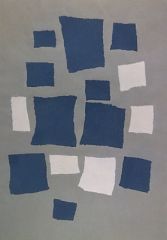
?
|
|
|
Marcel Duchamp, Fountain, 1917.
Dada. ready-mades mvoed toward artistic process that was ambivielnt to talent, object became work of art because artist decided it should be as such. sought to undermine traditionalism. nature of new york dada was less oilitical than in europe and more satirical. submitted urinal under the name r.mutt, called it fountain. was an intrusion of industrial object in gallery. was rejected, showed limits of american avante garde |
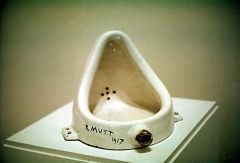
?
|
|
|
Marcel Duchamp, L.H.O.O.Q, 1919
Dada. changed mona lisa, L.H.O.O.Q., added beard and mustache, slogan in french could be read, "she is hot in the ass", turned mona lisa into a tramp. |
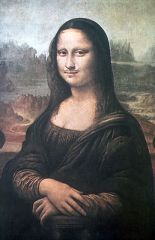
?
|
|
|
Marcel Duchamp, The Large Glass, 1915-23.
Dada. can be categorized as painting and sculpture. bride on top, prisoners on bottom. is between 2 planes of glass. distinctive technique of destroying conventions by showing objects and anaotmical?? impossibility of contact with bride and bachelors. |

?
|
|
|
Hannah Höch, Cut with the Kitchen Knife, 1919-20.
Dada. shows dada v anit dada. hoch was only women in dada culture, showed marraige in negative light, showed in favor the countries who gave women the right to vote. |
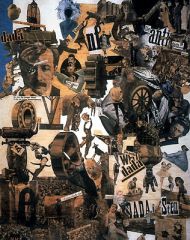
?
|
|
|
Max Beckmann, The Night, 1918-19
Dada. Depicting world violence. cramped room is shown with 3 intrudered. savageness.objects seem dislocated and contorted. powerful |
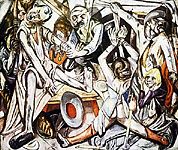
?
|
|
|
George Grosz, Fit for Active Service, 1916-17
was in war, had to transport POWs, most of his paintings show negative images of war |
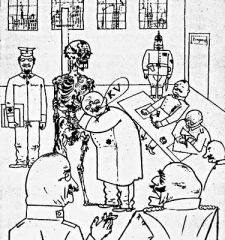
?
|
|
|
Otto Dix, Der Krieg (The War), 1929-32
|

?
|
|
|
Giorgio de Chirico, Mystery and Melancholy of a Street, 1914.
Surrealism. Simple, but sense of foreboding. Strangeness in familiar objects, questions reality. |
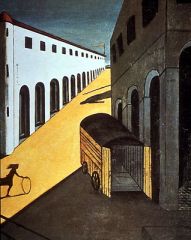
?
|
|
|
Salvador Dali, The Persistence of Memory, 1931
Surrealism. erotically charged hallucinatory visions. "hand painted dream photographs". monster in painting is supposed to be a self portrait, he calls it "the great masturbator". tried to discredit the world of reality, ultimate surrealist goal. self induced psychotic hallucinations so that he could create art. |
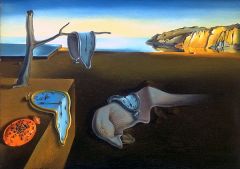
?
|
|
|
Max Ernst, Two Children are Threatened by a Nightingale, 1924.
Surrealism. two possible autobiographical references to nightingale: death of sister, and hallucination from when he was once ill."he who speaks of collage, speaks of the irrational". generation was very influences by dreams and childhood memories (frued). |
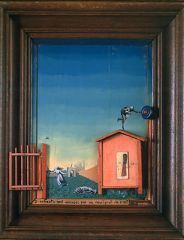
?
|
|
|
René Magritte, The Treachery (or Perfidy) of Images, 1928-29.
illusionistic surrealism. more amusing than philosophical. Dreamlike dissociation of image and meaning. |

?
|
|
|
Meret Oppenheim, Object (Le Dejeuner en fourrure), 1936
Surrealism. teacup is single most used surrealist object. wore fur trimmed bracelets, picasso said you could line anything in fur, she said even this cup and saucer. fur attracts the hands, rejects the tongue. mocking the prevailing masculinity of sculpture. disturbing and quietly aggressive. |

?
|
|
|
Frida Kahlo, Two Fridas, 1939
kahlo, from mexico city, mom was mexican, dad was german. was in trolley accident that caused her to be crippled. shows two backgrounds in two fridas. said she wasnt surrealist because she didnt paint dreams, she painted her own reality. |
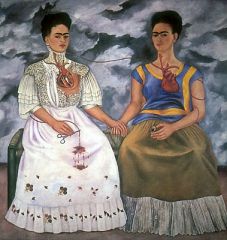
?
|
|
|
Joan Miro, Painting, 1933.
Transformed his subjecs through whimsical color and form. submerged unconscious. |
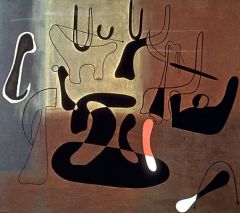
?
|
|
|
Pablo Picasso, Guernica, 1937.
became powerful symbol of brutality of war. concentrating on victims, used black grey and white to symbolize the newspaper pictures that shower the attrocities of the spanish war. bull represents franco, spanish dictator, picasso is shown with a lamp, revealing. |
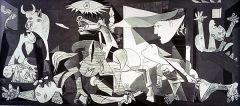
?
|
|
|
Paul Klee, Twittering Machine, 1922.
twittering machine. technically inventive paintings and drawings. twittering refers to birds. fusing of natural with industrial world. blue is night, pink is dawn. bear a resembelence to birds only in thier beaks. contrasts between humor and monstrousity. |
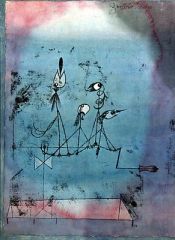
?
|
|
|
Naum Gabo, Column, ca. 1923
|
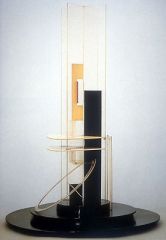
?
|
|
|
Kasimir Malevich, Suprematist Composition: Airplane Flying, 1915
|
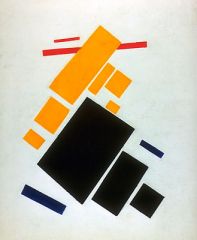
?
|
|
|
Kasimir Malevich, Suprematist Composition: White on White, 1918
|

?
|
|
|
Vladimir Tatlin, Project for Memorial to Third International, 1919-20
|

?
|
|
|
?
|
Piet Mondrian, Composition with Red, Blue and Yellow, 1930
|
|
|
Gerritt Thomas Rietveld, Schroder House, Utrecht, The Netherlands, 1924
|
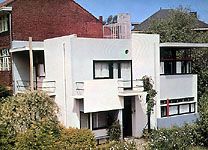
?
|
|
|
László Moholy-Nagy, From the Radio Tower Berlin, 1928
|
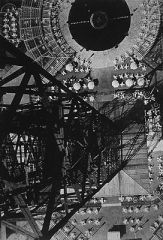
?
|
|
|
Walter Gropius, Bauhaus, Dessau, Germany, exterior, 1924
|
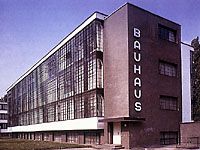
?
|
|
|
Marcel Breuer, Tubular Chair, 1925
|
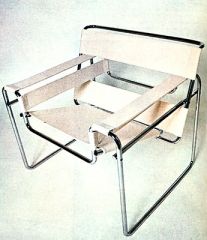
?
|
|
|
Gunta Stölzl, Gobelin tapestry, 1927-28
|
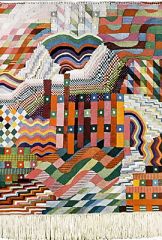
?
|
|
|
Ludwig Mies van der Rohe, Model for a Glass Skyscraper, 1922
|
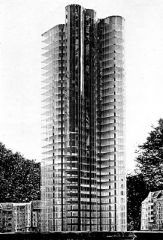
?
|
|
|
Le Corbusier, Villa Savoye, Poissy, France, 1929
|
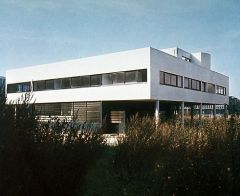
?
|
|
|
William Van Alen, Chrysler Building, New York City, 1928-30
Art Deco |
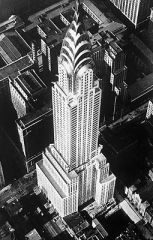
?
|
|
|
Frank Lloyd Wright, Robie House, Chicago, Illinois, 1907-1909.
Natural Architecture. |

?
|
|
|
Frank Lloyd Wright, Kaufmann House (Fallingwater), Bear Run, Pennsylvania, 1936-1939. Natural Architecture.
|
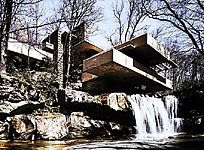
?
|
|
|
Constantin Brancusi, Bird in Space, 1928
|
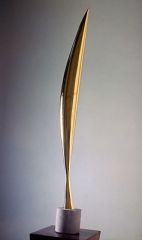
?
|
|
|
Barbara Hepworth, Oval Scuplture (No. 2), 1943
|
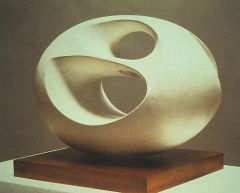
?
|
|
|
Henry Moore, Reclining Figure, 1939
|
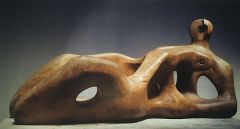
?
|
|
|
Alexander Calder, Unitiled, 1976
|
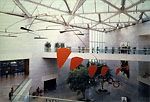
?
|
|
|
Installation Photo of the Armory Show, New York National Guard's 69th Regiment, New York, 1913
|
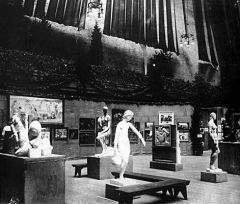
?
|
|
|
Alfred Stieglitz, The Steerage, 1907
|
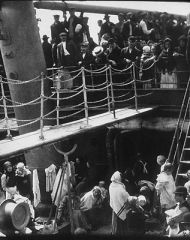
?
|
|
|
Marcel Duchamp, Nude Descending a Staircase, No. 2, 1913
|
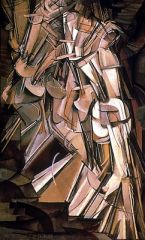
?
|
|
|
Edward Weston, Nude, 1925
|
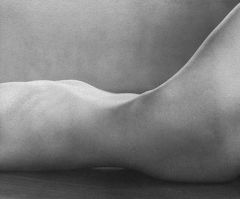
?
|
|
|
John Sloan, Sunday, Sixth Avenue and 30th Street, 1907
|
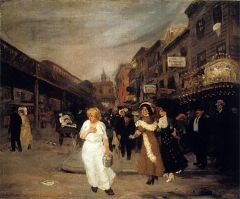
?
|
|
|
Marden Hartley, Portrait of a German Officer, 1914
|
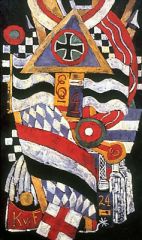
?
|
|
|
Stuart Davis, Lucky Strike, 1922
|
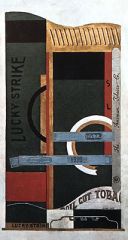
?
|
|
|
Charles Demuth, My Egypt, 1927
|
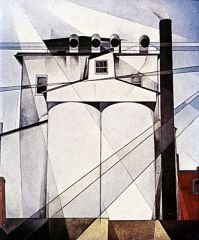
?
|
|
|
Aaron Douglas, Noah's Ark, ca. 1927
|

?
|
|
|
Georgia O'Keeffe, New York, Night, 1929
|

?
|
|
|
Grant Wood, American Gothic, 1930
American Modernism |
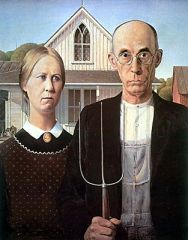
?
|
|
|
Dorothea Lange, Migrant Mother, Nipomo, CA, 1936
American Modernism |

?
|
|
|
Jacob Lawrence, Migration Series, No. 49, 1940-41
American Modernism |

?
|
|
|
Thomas Hart Benton, Pioneer Days and Early Settlers, 1936.
American Modernism |

?
|
|
|
José Clemente Orozco, Epic of American Civilization: Hispano-America, ca. 1932-34
|
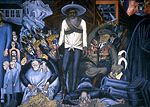
?
|
|
|
Diego Rivera, Ancient Mexico, from the History of Mexico fresco murals, 1929-1935
|

?
|
|
|
Francis Bacon, Painting, 1946
|
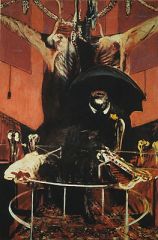
?
|
|
|
Alberto Giacometti, Man Pointing, 1947
|

?
|
|
|
Jackson Pollock, Number 1, 1950 (Lavender Mist), 1950.
Abstract Expressionism: Gestural abstraction |
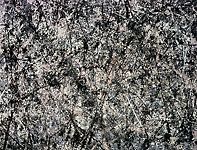
?
|
|
|
Willem De Kooning, Woman I, 1950-52.
Abstract Expressionism: Gestural abstraction |
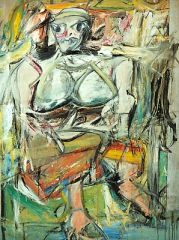
?
|
|
|
Barnett Newman, Vir Heroicus Sublimis, 1950-51
Abstract Expressionism: Chomatic abstractions |

?
|
|
|
Mark Rothko, No. 14, 1960.
Abstract Expressionism: Chomatic abstractions |
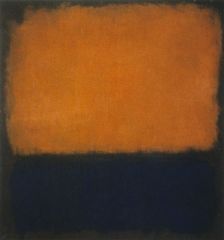
?
|
|
|
David Smith, Cubi XVIII, 1963-64
|
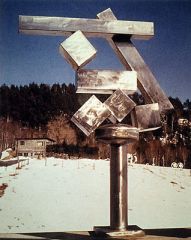
?
|
|
|
Ellsworth Kelly, Red, Blue, Green, 1963.
Post Painterly Abstraction: Hard Edged Painters |
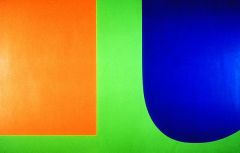
?
|
|
|
Frank Stella, Mas o Menos, 1964
Post Painterly Abstraction: Hard Edged Painters |
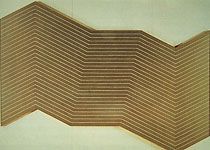
?
|
|
|
Helen Frankenthaler, Bay Side, 1967
Post Painterly Abstraction: Colorfield Painters |
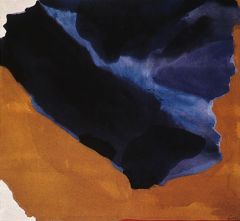
?
|
|
|
Morris Louis, Saraband, 1959
Post Painterly Abstraction: Colorfield Painters |
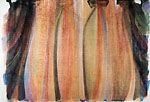
?
|
|
|
Tony Smith, Die, 1962
|
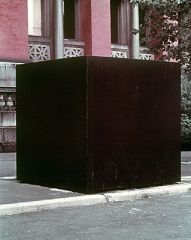
?
|
|
|
Donald Judd, Untitled, 1969
|

?
|
|
|
Louise Nevelson, Tropical Garden II, 1957-59
|

?
|
|
|
Louise Bourgeois, Cumul I, 1969
|
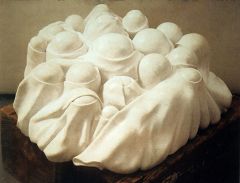
?
|
|
|
Eva Hesse, Hang-Up, 1965-66
|
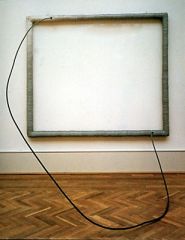
?
|
|
|
Jasper Johns, Flag, 1954-55
Pop Art |
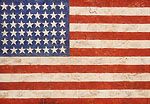
?
|
|
|
Robert Rauschenberg, Canyon, 1959
|
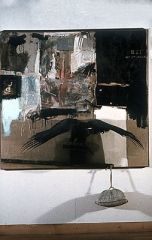
?
|
|
|
Richard Hamilton, Just What Is It That Makes Today's Homes Different, So Appealing?, 1956
Pop Art |
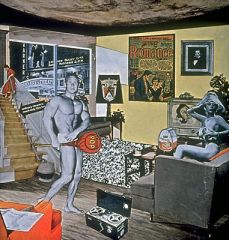
?
|
|
|
Roy Lichtenstein, Hopeless, 1962
Pop Art |
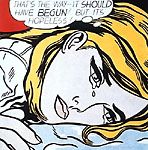
?
|
|
|
Andy Warhol, Green Coca-Cola Bottles, 1962
Pop Art |
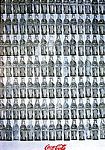
?
|
|
|
Andy Warhol, Marilyn Diptych, 1962
Pop Art |

?
|
|
|
Claes Oldenburg, photo of one-person show at the Green Gallery, 1962
Pop Art |
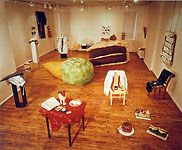
?
|
|
|
Claes Oldenburg, Lipstick, 1969
Pop Art |
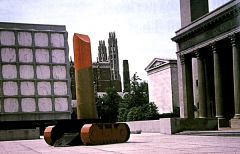
?
|
|
|
Claes Oldenburg, Floor Burger, 1962
Pop Art |
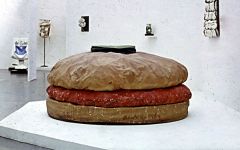
?
|
|
|
Chuck Close, Big Self-Portrait, 1967-68
Pop Art |

?
|
|
|
Duane Hanson, Supermarket Shopper, 1970
Pop Art |
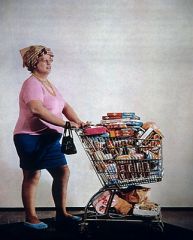
?
|

